ed. by Christhardt Henschel, Ruth Leiserowitz, Kamila Lenartowicz, Neele Menter, Zuzsanna Światowy
Osnabrück: fibre, 2024, 320 S., zahlr. Abb., geb , 15,5 x 23,5 cm, Sprache: Englisch
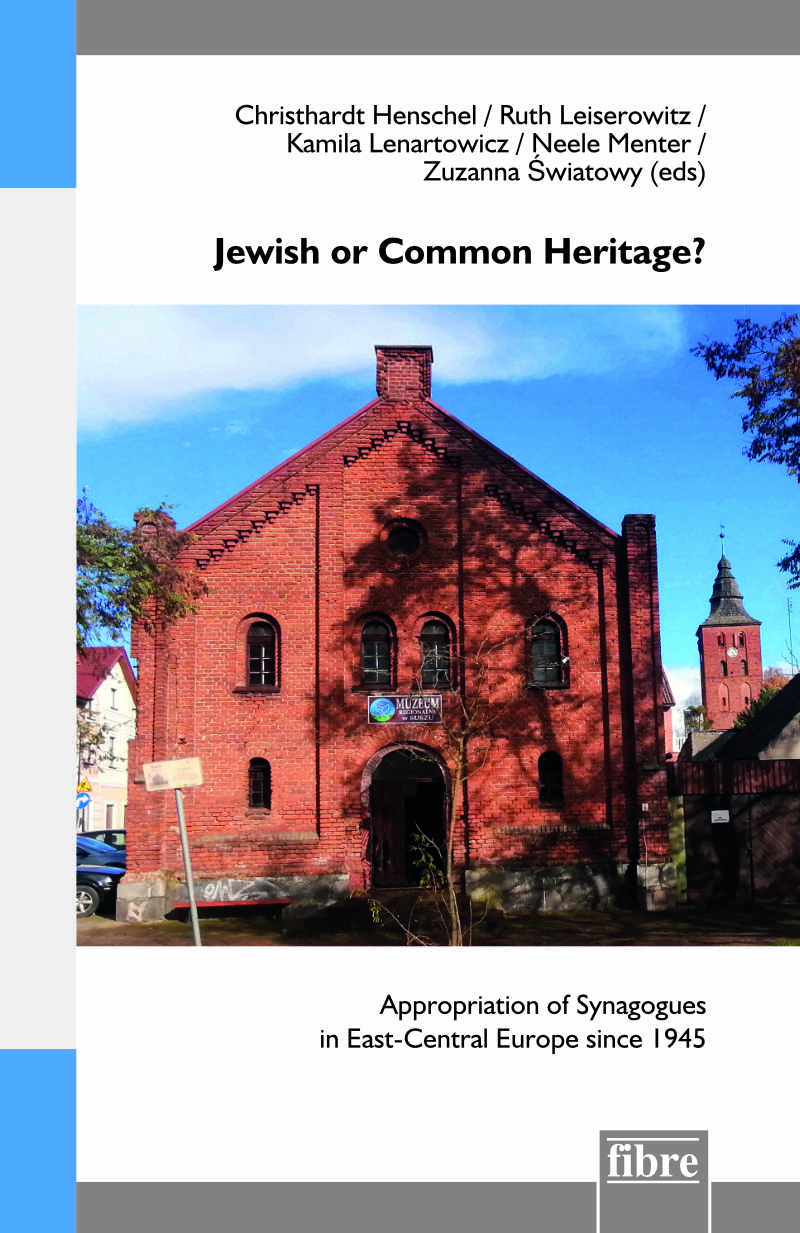 Die verwaiste Synagoge im städtischen Raum – wie setzen wir uns mit ihr auseinander? Auf den ersten Blick ist dies eine Frage, die in den Rahmen des zeitgenössischen, im nordamerikanischen Kontext entwickelten Konzepts der Critical Heritage Studies fällt. Allerdings befinden sich die in Augenschein genommenen Synagogen vor allem in Mittel- und Osteuropa, in verschiedenen polnischen Regionen, Litauen, der Tschechischen Republik, Kroatien, Ungarn, den westrumänischen Städten Oradea und Timişoara sowie in der Ukraine und Weißrussland.
Die verwaiste Synagoge im städtischen Raum – wie setzen wir uns mit ihr auseinander? Auf den ersten Blick ist dies eine Frage, die in den Rahmen des zeitgenössischen, im nordamerikanischen Kontext entwickelten Konzepts der Critical Heritage Studies fällt. Allerdings befinden sich die in Augenschein genommenen Synagogen vor allem in Mittel- und Osteuropa, in verschiedenen polnischen Regionen, Litauen, der Tschechischen Republik, Kroatien, Ungarn, den westrumänischen Städten Oradea und Timişoara sowie in der Ukraine und Weißrussland.
Dafür musste das Forschungskonzept in vielerlei Hinsicht an die regionalen Spezifika angepasst werden: Es lassen sich eine Reihe von Prozessen beobachten, die bisher wenig beschriebene Phasen, Dynamiken und Intensitäten aufweisen und durch Phänomene wie Entdämonisierung, Entideologisierung und Kontextualisierung, aber auch durch Aneignung, Korrektur- oder Verbesserungsversuche der Erhaltungspraxis gekennzeichnet sind. Der Band versammelt Analysen aus sehr unterschiedlichen Perspektiven – von transnationalen Ansätzen über Konzepte von Fachleuten bis hin zu Berichten lokaler Initiativen.
Inhaltsverzeichnis …
hg. von Cord-Friedrich Berghahn, Mirko Przystawik, Katrin Keßler & Ulrich Knufinke
Göttingen: Wallstein Verlag, 2022. 263 S., 47 Abb., geb., Schutzumschlag, 15,5 x 23 cm
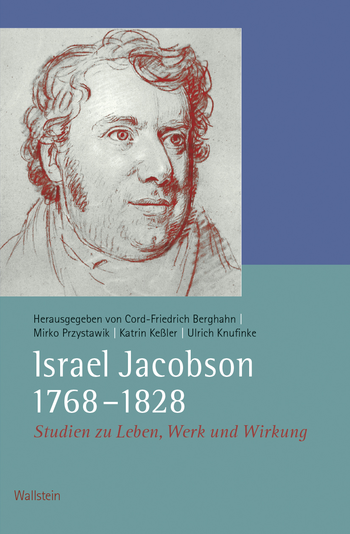 Israel Jacobson (*17. Oktober 1768, Halberstadt) wurde als Bankier und Rabbiner in Braunschweig zu einer führenden Persönlichkeit auf dem Weg zur Gleichberechtigung der Juden und zum Vorkämpfer der jüdischen Reformbewegung im Gefolge der jüdischen Aufklärung (Haskala). Die von ihm und seinen Mitstreitern vorangetriebene Bildungsreform, für die er mit der Gründung einer jüdischen Freischule in Seesen eine bis ins 20. Jahrhundert tätige Bildungsanstalt schuf, avancierte zum Ausgangspunkt der Teilhabe von Juden an der bürgerlichen Gesellschaft. Jacobsons Reform des jüdischen Gottesdienstes, die er im Seesener Jacobstempel umsetzte, schuf die Grundlagen für die bis heute in aller Welt praktizierten und diskutierten Ideen des Reformjudentums. Als
Philanthrop, Mäzen und Stifter ließ Jacobson aber auch die nicht-jüdische Bevölkerung an seinem Aufklärungswerk teilhaben. Als er im Jahr 1828 in Berlin starb, hatte in den Beziehungen zwischen Juden und Nicht-Juden bereits ein grundsätzlicher Wandel eingesetzt, dessen Wirkungen bis in die Gegenwart verfolgt werden können. Der vorliegende Band legt ein biographisches Handbuch en miniature mit einem offenen hermeneutischen Ansatz vor.
Israel Jacobson (*17. Oktober 1768, Halberstadt) wurde als Bankier und Rabbiner in Braunschweig zu einer führenden Persönlichkeit auf dem Weg zur Gleichberechtigung der Juden und zum Vorkämpfer der jüdischen Reformbewegung im Gefolge der jüdischen Aufklärung (Haskala). Die von ihm und seinen Mitstreitern vorangetriebene Bildungsreform, für die er mit der Gründung einer jüdischen Freischule in Seesen eine bis ins 20. Jahrhundert tätige Bildungsanstalt schuf, avancierte zum Ausgangspunkt der Teilhabe von Juden an der bürgerlichen Gesellschaft. Jacobsons Reform des jüdischen Gottesdienstes, die er im Seesener Jacobstempel umsetzte, schuf die Grundlagen für die bis heute in aller Welt praktizierten und diskutierten Ideen des Reformjudentums. Als
Philanthrop, Mäzen und Stifter ließ Jacobson aber auch die nicht-jüdische Bevölkerung an seinem Aufklärungswerk teilhaben. Als er im Jahr 1828 in Berlin starb, hatte in den Beziehungen zwischen Juden und Nicht-Juden bereits ein grundsätzlicher Wandel eingesetzt, dessen Wirkungen bis in die Gegenwart verfolgt werden können. Der vorliegende Band legt ein biographisches Handbuch en miniature mit einem offenen hermeneutischen Ansatz vor.
by Sergey R. Kravtsov, with preface by Ilia Rodov
Weimar: Grünberg Verlag, 2018. 294 pages, ca. 100 ills, paperback
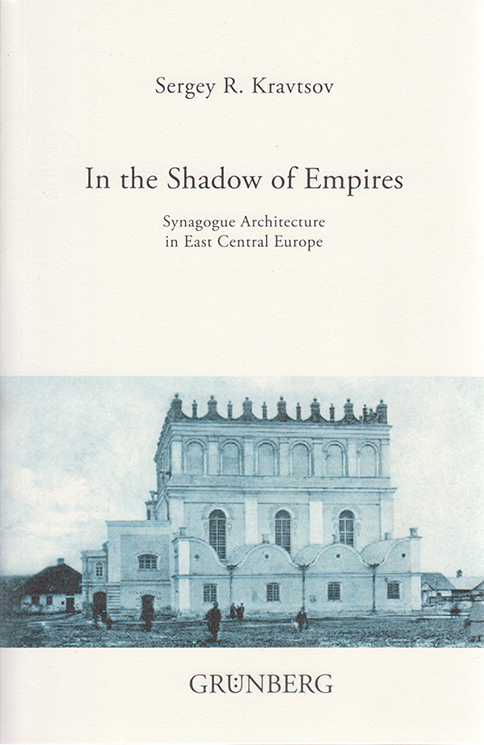
These meticulously researched and clearly presented articles create new ways of looking at East European Jewish architecture that goes beyond the necessary but often superficial country surveys of the past few decades. While collectively presenting an important overview of the development and spread of synagogue types and forms, each article attacks a specific question about why and how buildings were built and what this teaches us about religion, politics, economics, and intellectual circumstances of the period and the Jewish mindset of that time and place. Kravtsov is this generation’s foremost historian of synagogue architecture and here he gives meaning to what otherwise would be abstract and empty form.”
Samuel D. Gruber – President, International Survey of Jewish Monuments —
by Sergey R. Kravtsov and Vladimir Levin
2 vols., Jerusalem, 2017. Zalman Shazar Center and Center for Jewish Art
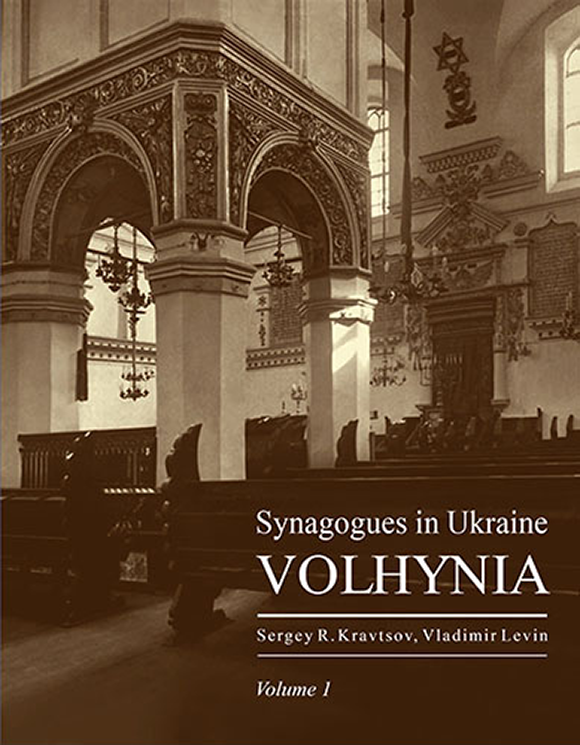
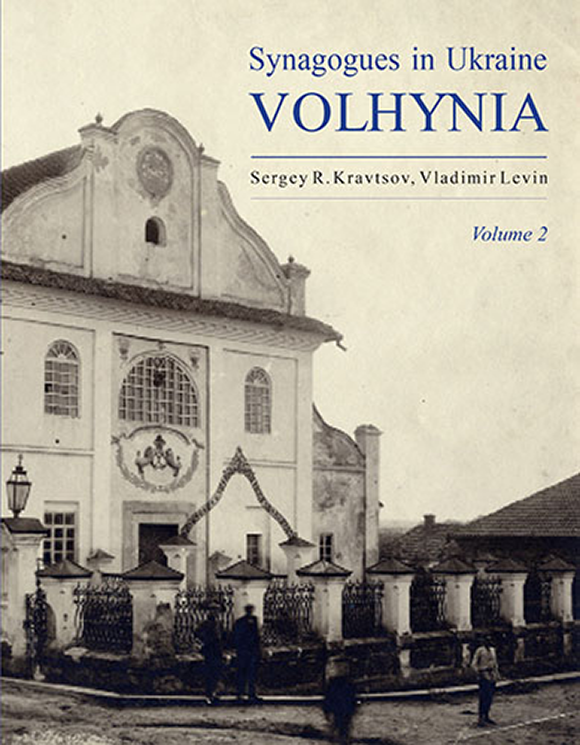 Synagogues in Ukraine: Volhynia written by Sergey R. Kravtsov and Vladimir Levin of the Center for Jewish Art at the Hebrew University of Jerusalem is devoted to the history and architecture of synagogues throughout the historical region of Volhynia in northwest Ukraine. The two-volume book of 848 pages is richly illustrated with 1,220 color and b/w photographs, measured drawings of the synagogues and numerous maps. According to Prof. Shaul Stampfer, this is “a reference book that is reliable, comprehensive – and exciting to read and reread.” The book deals with 39 extant and 302 vanished synagogues, situated in 23 cities and towns: Berestechko, Chervonoarmiisk (Pulin), Dubno, Horodnytsia, Iziaslav (Zaslaw), Klevan, Kovel, Kremenets, Lutsk, Mlyniv, Novohrad-Volynskyi (Zvil), Olevsk, Ostroh, Polonne, Radyvyliv, Rivne, Shepetivka, Slavuta, Starokostiantyniv, Turiisk, Volodymyr-Volynskyi (Ludmir), Vyshnivets, and Zhytomyr. Three introductory articles provide a general overview and research on various aspects of the synagogues: "The Legal History of Synagogues in Volhynia," "Synagogue Architecture of Volhynia," and "The Social Function of Synagogue Ceremonial Objects in Volhynia."
Synagogues in Ukraine: Volhynia written by Sergey R. Kravtsov and Vladimir Levin of the Center for Jewish Art at the Hebrew University of Jerusalem is devoted to the history and architecture of synagogues throughout the historical region of Volhynia in northwest Ukraine. The two-volume book of 848 pages is richly illustrated with 1,220 color and b/w photographs, measured drawings of the synagogues and numerous maps. According to Prof. Shaul Stampfer, this is “a reference book that is reliable, comprehensive – and exciting to read and reread.” The book deals with 39 extant and 302 vanished synagogues, situated in 23 cities and towns: Berestechko, Chervonoarmiisk (Pulin), Dubno, Horodnytsia, Iziaslav (Zaslaw), Klevan, Kovel, Kremenets, Lutsk, Mlyniv, Novohrad-Volynskyi (Zvil), Olevsk, Ostroh, Polonne, Radyvyliv, Rivne, Shepetivka, Slavuta, Starokostiantyniv, Turiisk, Volodymyr-Volynskyi (Ludmir), Vyshnivets, and Zhytomyr. Three introductory articles provide a general overview and research on various aspects of the synagogues: "The Legal History of Synagogues in Volhynia," "Synagogue Architecture of Volhynia," and "The Social Function of Synagogue Ceremonial Objects in Volhynia."
ed. by Aliza Cohen- Mushlin, Sergey Kravtsov, Vladimir Levin, Giedrė Mickūnaite and Jurgita Šiauciūnaitė-Verbickienė
vergriffen/out of print 2 vols., Vilnius, 2010–2012, Vilnius Academy of Arts Press
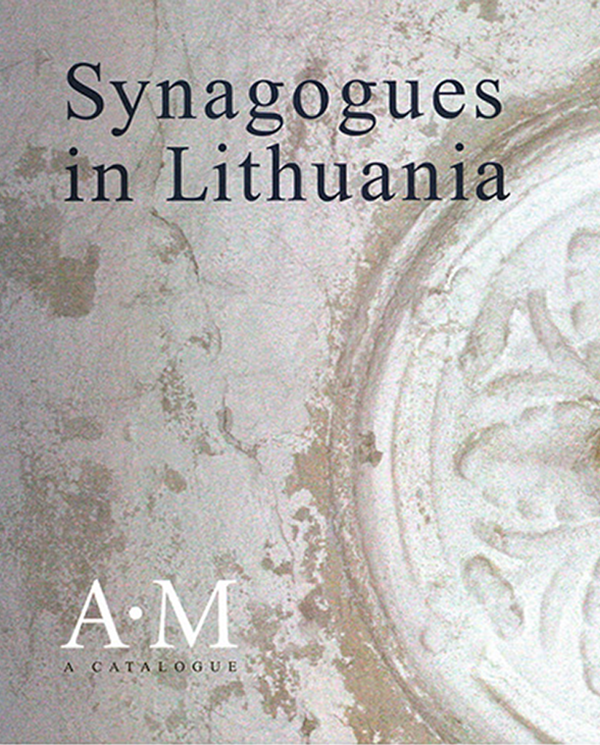
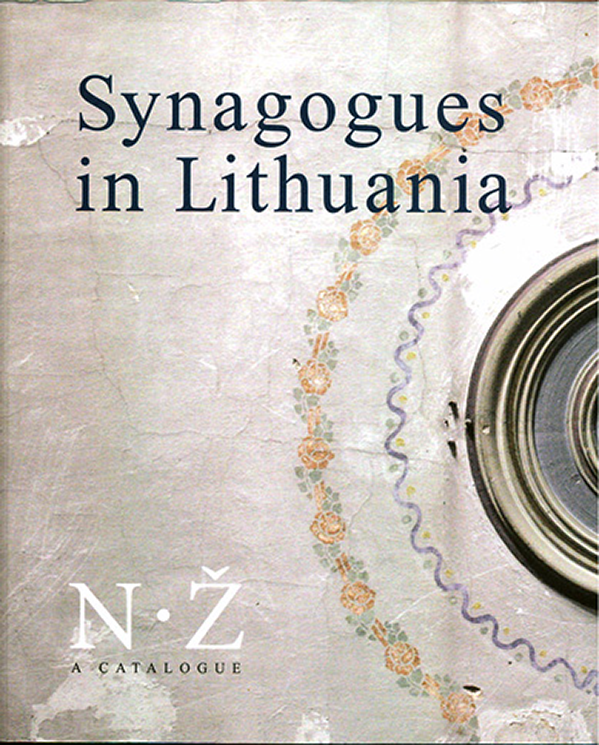 This publication offers a catalogue of the extant synagogues in Lithuania: 96 buildings in 59 cities and towns, among them 17 synagogues built of wood. Until World War II there were about 1,000 Jewish prayer houses in Lithuania, while today only 10% exist, many abandoned and in different state of deterioration. Only three synagogues are active.
The catalogue consists of 59 geographical entries. Each entry includes a short overview of the history of the Jewish community in the town where a synagogue is preserved, comprehensive information about the vanished synagogues in that town and a detailed description of the extant synagogue building or buildings. The entries are richly illustrated with archival historical photographs and architectural designs of the synagogues, and recent documentation of the extant buildings with measured architectural drawings. The catalogue has two introductory articles: “Synagogues in Lithuania: A Historical Overview” by Dr. Vladimir Levin and “Synagogue Architecture in Lithuania” by Dr. Sergey Kravtsov.
This publication offers a catalogue of the extant synagogues in Lithuania: 96 buildings in 59 cities and towns, among them 17 synagogues built of wood. Until World War II there were about 1,000 Jewish prayer houses in Lithuania, while today only 10% exist, many abandoned and in different state of deterioration. Only three synagogues are active.
The catalogue consists of 59 geographical entries. Each entry includes a short overview of the history of the Jewish community in the town where a synagogue is preserved, comprehensive information about the vanished synagogues in that town and a detailed description of the extant synagogue building or buildings. The entries are richly illustrated with archival historical photographs and architectural designs of the synagogues, and recent documentation of the extant buildings with measured architectural drawings. The catalogue has two introductory articles: “Synagogues in Lithuania: A Historical Overview” by Dr. Vladimir Levin and “Synagogue Architecture in Lithuania” by Dr. Sergey Kravtsov.
The catalogue includes the following entries:
Alanta, Alsėdžiai, Alytus, Anykščiai, Balbieriškis, Biržai, Čekiškė, Daugai, Eišiškės, Jonava, Joniškėlis, Joniškis, Kaltinėnai, Kalvarija, Kaunas, Kėdainiai, Klaipėda, Krekenava, Kupiškis, Kurkliai, Laukuva, Lazdijai, Linkuva, Lygumai, Marijampolė, Merkinė, Pakruojis, Panevėžys, Pasvalys, Plungė, Prienai, Pušalotas, Raguva, Ramygala, Rietavas, Rozalimas, Salantai, Seda, Šeta, Šiauliai, Šilalė, Simnas, Širvintos, Skaudvilė, Švėkšna, Telšiai, Tirkšliai, Troškūnai, Ukmergė, Utena, Vabalninkas, Veisiejai, Vilnius, Vištytis, Žagarė, Zarasai, Žasliai, Žemaičių Naumiestis, Žiežmariai.
 Die verwaiste Synagoge im städtischen Raum – wie setzen wir uns mit ihr auseinander? Auf den ersten Blick ist dies eine Frage, die in den Rahmen des zeitgenössischen, im nordamerikanischen Kontext entwickelten Konzepts der Critical Heritage Studies fällt. Allerdings befinden sich die in Augenschein genommenen Synagogen vor allem in Mittel- und Osteuropa, in verschiedenen polnischen Regionen, Litauen, der Tschechischen Republik, Kroatien, Ungarn, den westrumänischen Städten Oradea und Timişoara sowie in der Ukraine und Weißrussland.
Die verwaiste Synagoge im städtischen Raum – wie setzen wir uns mit ihr auseinander? Auf den ersten Blick ist dies eine Frage, die in den Rahmen des zeitgenössischen, im nordamerikanischen Kontext entwickelten Konzepts der Critical Heritage Studies fällt. Allerdings befinden sich die in Augenschein genommenen Synagogen vor allem in Mittel- und Osteuropa, in verschiedenen polnischen Regionen, Litauen, der Tschechischen Republik, Kroatien, Ungarn, den westrumänischen Städten Oradea und Timişoara sowie in der Ukraine und Weißrussland.

 Israel Jacobson (*17. Oktober 1768, Halberstadt) wurde als Bankier und Rabbiner in Braunschweig zu einer führenden Persönlichkeit auf dem Weg zur Gleichberechtigung der Juden und zum Vorkämpfer der jüdischen Reformbewegung im Gefolge der jüdischen Aufklärung (Haskala). Die von ihm und seinen Mitstreitern vorangetriebene Bildungsreform, für die er mit der Gründung einer jüdischen Freischule in Seesen eine bis ins 20. Jahrhundert tätige Bildungsanstalt schuf, avancierte zum Ausgangspunkt der Teilhabe von Juden an der bürgerlichen Gesellschaft. Jacobsons Reform des jüdischen Gottesdienstes, die er im Seesener Jacobstempel umsetzte, schuf die Grundlagen für die bis heute in aller Welt praktizierten und diskutierten Ideen des Reformjudentums. Als
Philanthrop, Mäzen und Stifter ließ Jacobson aber auch die nicht-jüdische Bevölkerung an seinem Aufklärungswerk teilhaben. Als er im Jahr 1828 in Berlin starb, hatte in den Beziehungen zwischen Juden und Nicht-Juden bereits ein grundsätzlicher Wandel eingesetzt, dessen Wirkungen bis in die Gegenwart verfolgt werden können. Der vorliegende Band legt ein biographisches Handbuch en miniature mit einem offenen hermeneutischen Ansatz vor.
Israel Jacobson (*17. Oktober 1768, Halberstadt) wurde als Bankier und Rabbiner in Braunschweig zu einer führenden Persönlichkeit auf dem Weg zur Gleichberechtigung der Juden und zum Vorkämpfer der jüdischen Reformbewegung im Gefolge der jüdischen Aufklärung (Haskala). Die von ihm und seinen Mitstreitern vorangetriebene Bildungsreform, für die er mit der Gründung einer jüdischen Freischule in Seesen eine bis ins 20. Jahrhundert tätige Bildungsanstalt schuf, avancierte zum Ausgangspunkt der Teilhabe von Juden an der bürgerlichen Gesellschaft. Jacobsons Reform des jüdischen Gottesdienstes, die er im Seesener Jacobstempel umsetzte, schuf die Grundlagen für die bis heute in aller Welt praktizierten und diskutierten Ideen des Reformjudentums. Als
Philanthrop, Mäzen und Stifter ließ Jacobson aber auch die nicht-jüdische Bevölkerung an seinem Aufklärungswerk teilhaben. Als er im Jahr 1828 in Berlin starb, hatte in den Beziehungen zwischen Juden und Nicht-Juden bereits ein grundsätzlicher Wandel eingesetzt, dessen Wirkungen bis in die Gegenwart verfolgt werden können. Der vorliegende Band legt ein biographisches Handbuch en miniature mit einem offenen hermeneutischen Ansatz vor.


 Synagogues in Ukraine: Volhynia written by Sergey R. Kravtsov and Vladimir Levin of the Center for Jewish Art at the Hebrew University of Jerusalem is devoted to the history and architecture of synagogues throughout the historical region of Volhynia in northwest Ukraine. The two-volume book of 848 pages is richly illustrated with 1,220 color and b/w photographs, measured drawings of the synagogues and numerous maps. According to Prof. Shaul Stampfer, this is “a reference book that is reliable, comprehensive – and exciting to read and reread.” The book deals with 39 extant and 302 vanished synagogues, situated in 23 cities and towns: Berestechko, Chervonoarmiisk (Pulin), Dubno, Horodnytsia, Iziaslav (Zaslaw), Klevan, Kovel, Kremenets, Lutsk, Mlyniv, Novohrad-Volynskyi (Zvil), Olevsk, Ostroh, Polonne, Radyvyliv, Rivne, Shepetivka, Slavuta, Starokostiantyniv, Turiisk, Volodymyr-Volynskyi (Ludmir), Vyshnivets, and Zhytomyr. Three introductory articles provide a general overview and research on various aspects of the synagogues: "The Legal History of Synagogues in Volhynia," "Synagogue Architecture of Volhynia," and "The Social Function of Synagogue Ceremonial Objects in Volhynia."
Synagogues in Ukraine: Volhynia written by Sergey R. Kravtsov and Vladimir Levin of the Center for Jewish Art at the Hebrew University of Jerusalem is devoted to the history and architecture of synagogues throughout the historical region of Volhynia in northwest Ukraine. The two-volume book of 848 pages is richly illustrated with 1,220 color and b/w photographs, measured drawings of the synagogues and numerous maps. According to Prof. Shaul Stampfer, this is “a reference book that is reliable, comprehensive – and exciting to read and reread.” The book deals with 39 extant and 302 vanished synagogues, situated in 23 cities and towns: Berestechko, Chervonoarmiisk (Pulin), Dubno, Horodnytsia, Iziaslav (Zaslaw), Klevan, Kovel, Kremenets, Lutsk, Mlyniv, Novohrad-Volynskyi (Zvil), Olevsk, Ostroh, Polonne, Radyvyliv, Rivne, Shepetivka, Slavuta, Starokostiantyniv, Turiisk, Volodymyr-Volynskyi (Ludmir), Vyshnivets, and Zhytomyr. Three introductory articles provide a general overview and research on various aspects of the synagogues: "The Legal History of Synagogues in Volhynia," "Synagogue Architecture of Volhynia," and "The Social Function of Synagogue Ceremonial Objects in Volhynia."
 This publication offers a catalogue of the extant synagogues in Lithuania: 96 buildings in 59 cities and towns, among them 17 synagogues built of wood. Until World War II there were about 1,000 Jewish prayer houses in Lithuania, while today only 10% exist, many abandoned and in different state of deterioration. Only three synagogues are active.
The catalogue consists of 59 geographical entries. Each entry includes a short overview of the history of the Jewish community in the town where a synagogue is preserved, comprehensive information about the vanished synagogues in that town and a detailed description of the extant synagogue building or buildings. The entries are richly illustrated with archival historical photographs and architectural designs of the synagogues, and recent documentation of the extant buildings with measured architectural drawings. The catalogue has two introductory articles: “Synagogues in Lithuania: A Historical Overview” by Dr. Vladimir Levin and “Synagogue Architecture in Lithuania” by Dr. Sergey Kravtsov.
This publication offers a catalogue of the extant synagogues in Lithuania: 96 buildings in 59 cities and towns, among them 17 synagogues built of wood. Until World War II there were about 1,000 Jewish prayer houses in Lithuania, while today only 10% exist, many abandoned and in different state of deterioration. Only three synagogues are active.
The catalogue consists of 59 geographical entries. Each entry includes a short overview of the history of the Jewish community in the town where a synagogue is preserved, comprehensive information about the vanished synagogues in that town and a detailed description of the extant synagogue building or buildings. The entries are richly illustrated with archival historical photographs and architectural designs of the synagogues, and recent documentation of the extant buildings with measured architectural drawings. The catalogue has two introductory articles: “Synagogues in Lithuania: A Historical Overview” by Dr. Vladimir Levin and “Synagogue Architecture in Lithuania” by Dr. Sergey Kravtsov.